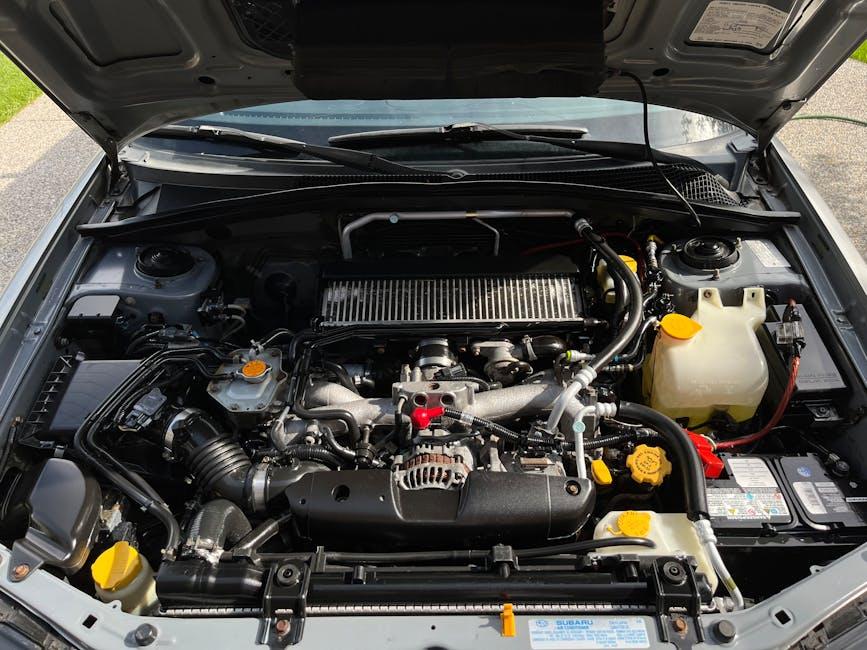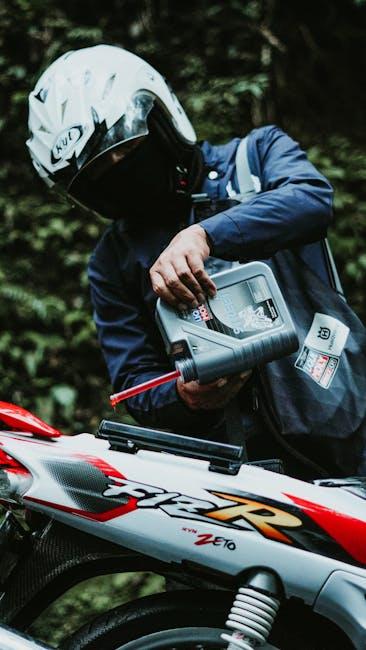Changing your car’s oil might seem like a job best left to the professionals, but with a little guidance and a bit of confidence, it’s a task you can easily master in your own driveway. Not only does performing a DIY oil change save you money, but it also gives you a chance to connect with your vehicle on a more personal level. Whether you’re a seasoned car enthusiast or a curious beginner, this step-by-step guide will walk you through the essentials of changing your oil safely and efficiently, helping your engine run smoother and extend its lifespan. So grab your tools, roll up your sleeves, and let’s get started on this empowering automotive adventure.
Table of Contents
- Choosing the Right Oil and Filter for Your Vehicle
- Preparing Your Workspace and Gathering Essential Tools
- Draining the Old Oil Safely and Efficiently
- Replacing the Oil Filter with Careful Precision
- Refilling with Fresh Oil and Checking Levels
- Disposing of Used Oil Responsibly and Environmentally
- Q&A
- Future Outlook

Choosing the Right Oil and Filter for Your Vehicle
Opting for the perfect oil and filter combination is crucial to keeping your engine humming smoothly. Start by consulting your vehicle’s owner manual; it’s your best friend for specifying the recommended oil grade and filter type. Common oil options include conventional, synthetic blend, and full synthetic—each catering to different engine needs and driving habits. Remember, using the correct oil viscosity ensures optimal performance and longevity, especially under varying temperatures and driving conditions.
When selecting an oil filter, focus on key features such as filtration efficiency, build quality, and compatibility with your car model. Not all filters are created equal, and a premium filter can trap more contaminants, thus extending engine life. Below is a quick reference table summarizing typical oil types and their benefits to help guide your choice:
| Oil Type | Best For | Key Advantage |
|---|---|---|
| Conventional | Daily driving, older models | Cost-effective and widely available |
| Synthetic Blend | Moderate performance needs | Improved protection at a reasonable price |
| Full Synthetic | High-performance & extreme conditions | Superior engine protection and efficiency |

Preparing Your Workspace and Gathering Essential Tools
Before diving into the oil change process, setting up an efficient and safe workspace is key. Opt for a flat, stable surface—ideally a garage floor or driveway—where you have enough room to maneuver without distractions. Ensure the area is well-ventilated to avoid inhaling any fumes, and keep a sturdy jack and jack stands on hand if you need to elevate your vehicle. Having a bright light source nearby allows you to spot potential spills or parts that need extra attention.
Next, gather all necessary tools and materials to streamline your workflow. Here’s a quick checklist to get you started:
- Engine oil suitable for your vehicle’s specifications
- Oil filter replacement compatible with your car model
- Oil drain pan to catch used oil
- Socket wrench or appropriate spanner for the drain plug
- Oil filter wrench for removing the old filter
- Funnel for clean oil pouring
- Rags or paper towels for quick clean-ups
- Gloves to protect your hands from oil
- Safety glasses to prevent any splashes into your eyes
| Tool | Purpose |
|---|---|
| Oil Drain Pan | Catches old oil to prevent spills |
| Socket Wrench | Loosens and tightens drain plug |
| Oil Filter Wrench | Removes stubborn oil filters easily |
| Funnel | Ensures mess-free oil filling |

Draining the Old Oil Safely and Efficiently
Begin by warming up your engine for a few minutes to help the old oil flow out smoothly. Once the car is off and safely lifted on jack stands or ramps, place a sturdy drain pan beneath the oil drain plug. Use a suitable wrench to carefully loosen the plug, turning it counterclockwise. Be sure to wear durable gloves to protect your hands from hot oil. Allow the oil to drain completely without rushing this step, as partial drainage can leave behind contaminants and reduce the effectiveness of the new oil.
After the oil has fully drained, inspect the drain plug and its gasket for wear and replace them if necessary to avoid leaks. Seal the drain plug tightly, but avoid overtightening as it may strip the threads. During this process, keep these key safety tips in mind:
- Always position the drain pan directly under the plug to catch all oil.
- Never discard used oil in regular trash; recycle it at certified centers.
- Use eye protection to avoid splashes.
| Tip | Reason |
|---|---|
| Pre-warm engine | Improves oil drainage |
| Use quality gloves | Protects from hot oil |
| Recycle used oil | Environmental safety |

Replacing the Oil Filter with Careful Precision
When it comes to swapping out the oil filter, precision is your best ally. First, make sure the engine is cool to avoid burns and prevent contamination of the new filter. Use a clean rag to wipe the mounting surface, ensuring no old gasket remnants or debris remain. Before screwing on the new filter, apply a thin layer of fresh oil to the rubber gasket—this small step helps create a perfect seal and makes future removal easier. Hand-tighten the filter gently; overtightening can damage the gasket or the filter itself, leading to leaks.
To keep this process smooth and mistake-free, follow these essential tips:
- Use the correct filter type specified for your vehicle to ensure compatibility.
- Inspect the old filter’s gasket to confirm it didn’t stick to the engine mount.
- Keep tools and surroundings clean to avoid introducing contaminants during installation.
| Step | Purpose | Tip |
|---|---|---|
| Clean Mounting Surface | Prevent leaks | Use a lint-free cloth |
| Lubricate Gasket | Seal & ease removal | Apply fresh oil evenly |
| Hand-Tighten Filter | Avoid damage | Stop once resistant |

Refilling with Fresh Oil and Checking Levels
Once the old oil has drained entirely, it’s time to pour in the fresh lubricant that will keep your engine humming smoothly. Start by consulting your vehicle’s owner manual to determine the exact type and amount of oil needed. Using a clean funnel, slowly add the new oil into the fill port, being careful not to spill. It’s essential to add the oil gradually, checking the level frequently to avoid overfilling, which can cause engine damage or leaks.
After adding oil, let your vehicle sit for a minute to allow the oil to settle. Then, use the dipstick to check the oil level: pull it out, wipe it clean with a cloth, reinsert fully, and pull it out again to observe the level. The dipstick will have markings indicating the ideal oil range. If the oil is below the recommended mark, add a little more and recheck. Remember, maintaining the correct oil level ensures optimal engine performance and longevity.
| Oil Level Indicator | Meaning |
|---|---|
| Low | Add oil immediately |
| Optimal | Safe to operate |
| High | Drain excess oil |
- Tip: Always use the recommended oil grade.
- Warning: Avoid overfilling to prevent engine seals damage.

Disposing of Used Oil Responsibly and Environmentally
Proper disposal of used oil is not just a legal necessity but an environmental imperative. When handling this hazardous waste, always store the oil in a clean, leak-proof container with a secure lid to prevent spills. Avoid mixing it with other fluids like antifreeze or solvents, which can complicate recycling processes. Take advantage of local recycling centers or auto shops that accept used oil — many communities offer free drop-off points designed to keep these pollutants out of waterways and soil.
Here’s a checklist to make responsible disposal simple and effective:
- Use a resealable, sturdy container specifically for used oil storage.
- Label the container clearly to avoid confusion with other waste.
- Locate authorized recycling facilities nearby via online directories or municipal resources.
- Never pour used oil down drains, on the ground, or in the trash.
| Disposal Option | Benefits | Where to Find |
|---|---|---|
| Recycling Centers | Oil reprocessing; environmental safety | Check municipal websites or local recycling guides |
| Auto Repair Shops | Convenient drop-off points; expert handling | Local garages or dealerships |
| Household Hazardous Waste Events | Safe community disposal drives | Seasonal events by local government |
Q&A
Q&A: DIY Oil Change – A Step-by-Step Guide
Q1: Why should I consider doing an oil change myself?
A1: Changing your own oil can save you money, give you a sense of accomplishment, and help you become more familiar with your vehicle’s maintenance needs. Plus, it’s a great way to reduce trips to the mechanic for routine services.
Q2: What tools and materials will I need to perform a DIY oil change?
A2: You’ll need fresh engine oil, a new oil filter, an oil filter wrench, a socket or wrench set to remove the drain plug, an oil drain pan, a funnel, gloves, and some rags. Optional but helpful: a jack or ramps to lift the car safely.
Q3: How do I know which oil and filter are right for my car?
A3: Consult your owner’s manual—it provides the exact oil viscosity and filter type recommended for your engine. Using the correct specifications ensures optimal engine performance and longevity.
Q4: Can I change my oil on any surface?
A4: It’s best to work on a flat, stable surface like a driveway or garage floor. This prevents the car from rolling and helps you access the drain plug easily. Avoid soft ground or gravel.
Q5: What’s the first step in the process?
A5: Start by warming up your engine for a few minutes. Warm oil drains more easily and carries away impurities better, but be careful—it will be hot!
Q6: How do I safely drain the old oil?
A6: Place the drain pan under the oil pan’s drain plug, then carefully loosen and remove the plug with your wrench. Let the oil drain completely into the pan. Remember to handle hot oil cautiously and avoid spills.
Q7: How do I replace the oil filter?
A7: Use the oil filter wrench to remove the old filter, turning it counterclockwise. Before installing the new filter, apply a light coating of fresh oil to the rubber gasket—this ensures a good seal and makes future removal easier.
Q8: How much new oil should I add?
A8: Check your owner’s manual for the exact quantity. Use the funnel to pour fresh oil into the engine, then check the dipstick to ensure levels are correct—avoid overfilling!
Q9: How do I dispose of the old oil and filter responsibly?
A9: Collect used oil and the old filter in sealed containers and take them to a local recycling center or auto shop that accepts used oil. Never pour oil down drains or onto the ground.
Q10: What are some common mistakes to avoid?
A10: Beware of overtightening the drain plug or oil filter, which can damage threads or gaskets. Also, double-check that the drain plug is securely tightened after draining to prevent leaks. Finally, don’t forget to reset any oil change reminders if your vehicle has them.
Doing your own oil change might seem daunting at first, but with a little preparation and patience, it’s a straightforward and rewarding task that keeps your engine running smoothly. Happy wrenching!
Future Outlook
Whether you’re a seasoned gearhead or a curious beginner, taking the plunge into a DIY oil change can be both empowering and practical. With the right tools, a bit of patience, and this step-by-step guide at your side, you’re equipped to give your engine the care it deserves—saving money and gaining confidence along the way. So roll up your sleeves, embrace the learning curve, and enjoy the satisfaction that comes with mastering a fundamental skill of vehicle maintenance. Your car will thank you with smoother rides and a healthier heart under the hood.


2 Comments
jscbp5
jscbp5